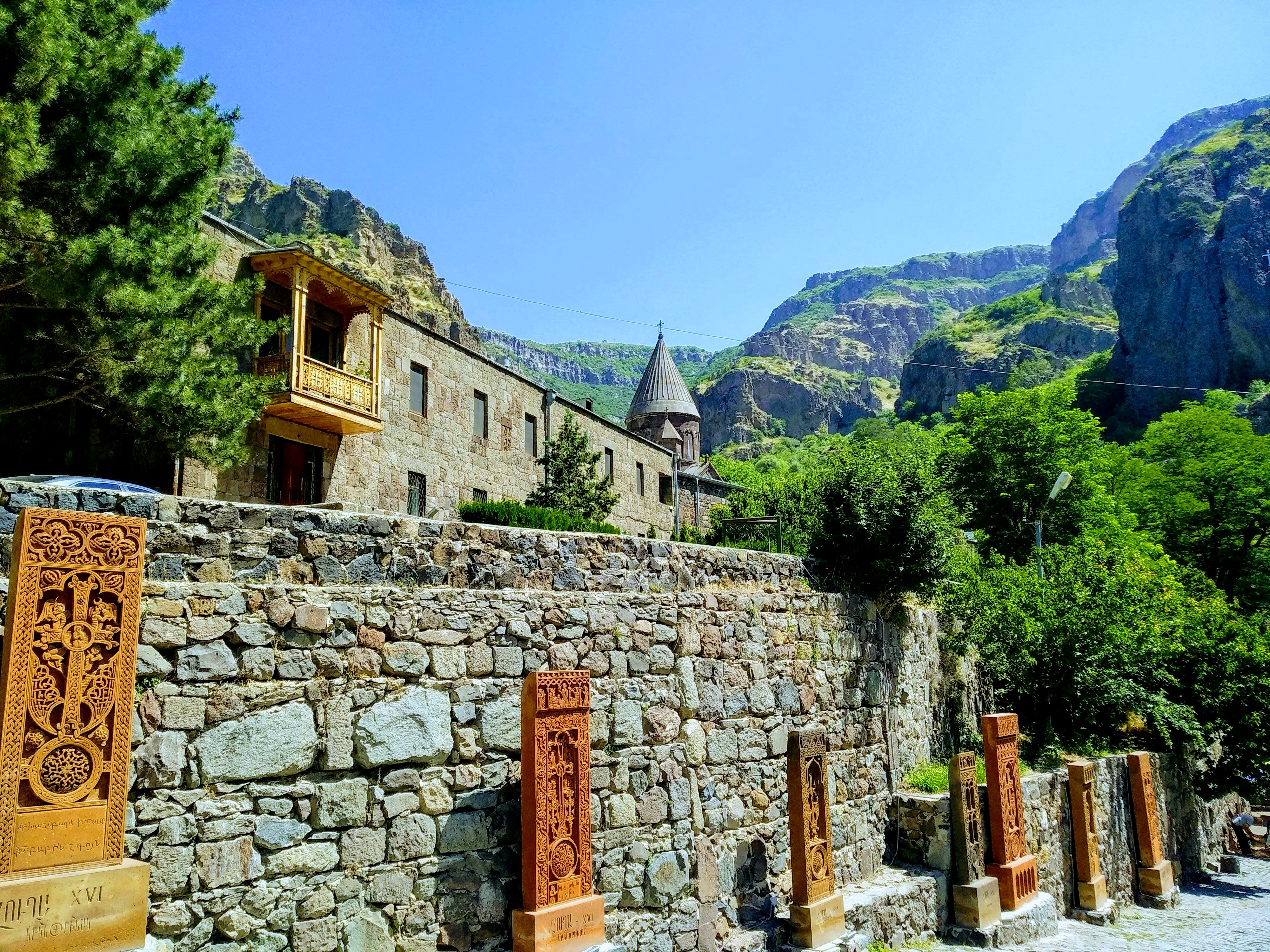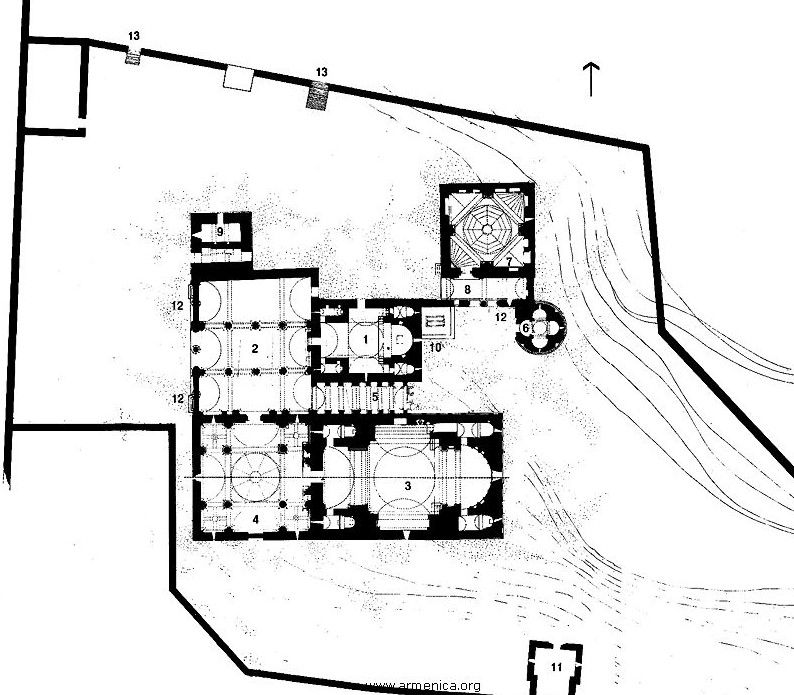|
Gavit
A ''gavit'' (Armenian ) or ''zhamatun'' (Armenian: ) is often contiguous to the west of a church in a Medieval Armenian monastery. It served as narthex The narthex is an architectural element typical of early Christian and Byzantine basilicas and churches consisting of the entrance or lobby area, located at the west end of the nave, opposite the church's main altar. Traditionally the narthex ... (entrance to the church), mausoleum and assembly room. History The ''gavit'', the distinctive Armenian style of narthex, appeared in the tenth and eleventh centuries. The first were located in the south of the Armenia in the region of Syunik. The type of construction changed during the twelfth and fourteenth centuries, as found in the monasteries of Saghmosavank of Haritchavank, or Hovhannavank Monastery. They changed again in the late thirteenth century as can be seen in monasteries such as Gandzasar, and gradually ceased to be built in the late Middle Ages. Structure The earli ... [...More Info...] [...Related Items...] OR: [Wikipedia] [Google] [Baidu] |
Geghard Gavit-IMG 2564
Geghard ( hy, Գեղարդ, meaning "spear") is a medieval monastery in the Kotayk province of Armenia, being partially carved out of the adjacent mountain, surrounded by cliffs. It is listed as a UNESCO World Heritage Site with enhanced protection status. While the main chapel was built in 1215, the monastery complex was founded in the 4th century by Gregory the Illuminator at the site of a sacred spring inside a cave. The monastery had thus been originally named Ayrivank (Այրիվանք), meaning "the Monastery of the Cave". The name commonly used for the monastery today, Geghard, or more fully Geghardavank (Գեղարդավանք), meaning "the Monastery of the Spear", originates from the spear which had wounded Jesus at the Crucifixion, allegedly brought to Armenia by Apostle Jude, called here Thaddeus, and stored amongst many other relics. Now it is displayed in the Echmiadzin treasury. The spectacular towering cliffs surrounding the monastery are part of the Azat Rive ... [...More Info...] [...Related Items...] OR: [Wikipedia] [Google] [Baidu] |
Armenia
Armenia (), , group=pron officially the Republic of Armenia,, is a landlocked country in the Armenian Highlands of Western Asia.The UNbr>classification of world regions places Armenia in Western Asia; the CIA World Factbook , , and ''Oxford Reference Online'' also place Armenia in Asia. It is a part of the Caucasus region; and is bordered by Turkey to the west, Georgia to the north, the Lachin corridor (under a Russian peacekeeping force) and Azerbaijan to the east, and Iran and the Azerbaijani exclave of Nakhchivan to the south. Yerevan is the capital, largest city and the financial center. Armenia is a unitary, multi-party, democratic nation-state with an ancient cultural heritage. The first Armenian state of Urartu was established in 860 BC, and by the 6th century BC it was replaced by the Satrapy of Armenia. The Kingdom of Armenia reached its height under Tigranes the Great in the 1st century BC and in the year 301 became the first state in the worl ... [...More Info...] [...Related Items...] OR: [Wikipedia] [Google] [Baidu] |
Narthex
The narthex is an architectural element typical of early Christian and Byzantine basilicas and churches consisting of the entrance or lobby area, located at the west end of the nave, opposite the church's main altar. Traditionally the narthex was a part of the church building, but was not considered part of the church proper. In early Christian churches the narthex was often divided into two distinct parts: an esonarthex (inner narthex) between the west wall and the body of the church proper, separated from the nave and aisles by a wall, arcade, colonnade, screen, or rail, and an external closed space, the exonarthex (outer narthex), a court in front of the church facade delimited on all sides by a colonnade as in the first St. Peter's Basilica in Rome or in the Basilica of Sant'Ambrogio in Milan. The exonarthex may have been either open or enclosed with a door leading to the outside, as in the Byzantine Chora Church. By extension, the narthex can also denote a covered p ... [...More Info...] [...Related Items...] OR: [Wikipedia] [Google] [Baidu] |
Ogive
An ogive ( ) is the roundly tapered end of a two-dimensional or three-dimensional object. Ogive curves and surfaces are used in engineering, architecture and woodworking. Etymology The earliest use of the word ''ogive'' is found in the 13th century sketchbook of Villard de Honnecourt, from Picardy in northern France. The ''Oxford English Dictionary'' considers the French term's origin obscure; it might come from the Late Latin , the feminine perfect passive participle of , meaning the one who has met or encountered the other. However, Merriam-Webster's dictionary says it is from the "Middle English stone comprising an arch, from Middle French diagonal arch". Types and use in applied physical science and engineering In ballistics or aerodynamics, an ogive is a pointed, curved surface mainly used to form the approximately streamlined nose of a bullet or other projectile, reducing air resistance or the drag of air. In fact the French word ''ogive'' can be translated as "nose ... [...More Info...] [...Related Items...] OR: [Wikipedia] [Google] [Baidu] |
Syunik Region
Syunik ( hy, Սյունիք, ) is the southernmost province of Armenia. It is bordered by the Vayots Dzor Province to the north, Azerbaijan's Nakhchivan Autonomous Republic exclave to the west, Azerbaijan to the east, and Iran to the south. Its capital and largest city is the town of Kapan. The Statistical Committee of Armenia reported its population was 141,771 in the 2011 census, down from 152,684 at the 2001 census. Etymology Syunik was one of the 15 provinces of the Kingdom of Armenia. The early Armenian historian Movses Khorenatsi connected the name of the province with Sisak, a descendant of the legendary Armenian patriarch Hayk and supposed progenitor of the ancient Siunia (or Syunik) dynasty, which ruled Syunik from the first century CE. However, historian Robert Hewsen considered Sisak to be a later eponym. Historian Armen Petrosyan suggested that Syunik is derived from name of the Urartian sun god Shivini/Siwini (itself a borrowing from the Hittites), noting ... [...More Info...] [...Related Items...] OR: [Wikipedia] [Google] [Baidu] |
Saghmosavank
The Saghmosavank ( hy, Սաղմոսավանք, lit. "monastery of the Psalms") is a 13th-century Armenian monastic complex located in the village of Saghmosavan in the Aragatsotn Province of Armenia. Like the Hovhannavank monastery which is five kilometers south, Saghmosavank is situated atop the precipitous gorge carved by the Kasagh river. Their silhouettes dominate the adjacent villages and rise sharp against the background of the mountains crowned by Mount Aragats.Architectural Ensembles of Armenia" O. Khalpakhchian, published in Moscow by Iskusstvo Publishers in 1980 The main structures of the monasteries erected by Prince Vache Vachutyan—the Church of Zion in Saghmosavank (1215) and the Church of Karapet in Hovhannavank (1216-1221)—belong to the same type of cross-winged domed structure with two-floor annexes in all the corners of the building. Subcupola space predominates in the interiors of both churches, which is reflected in the exterior shapes of these struct ... [...More Info...] [...Related Items...] OR: [Wikipedia] [Google] [Baidu] |
Hovhannavank
Hovhannavank ( hy, Հովհաննավանք) is a medieval monastery located in the village of Ohanavan in the Aragatsotn Province of Armenia. The monastery stands on the edge of the Kasagh River canyon, and its territory is adjacent to the village of Ohanavan. The deep gorge is carved by the Kasagh River. History and architecture The oldest part of the monastery is the single nave basilica of St. Karapet (i.e. Holy Forerunner, John the Baptist) that was founded at the beginning of the fourth century by St. Gregory the Enlightener, who baptized Armenia into the world's first Christian nation. The wooden roof of the early church was replaced in 554 AD with a thatch cover, and the basilica itself underwent profound renovation between 1652 and 1734. The centerpiece of the monastery is the Cathedral built between 1216 and 1221 through the donation of Prince Vache I Vachutian Amberdtsi (Վաչե Ա). The Cathedral has a cruciform floor plan, with two storey sacristies in each ... [...More Info...] [...Related Items...] OR: [Wikipedia] [Google] [Baidu] |
Sanahin Monastery
Sanahin Monastery is an Armenian monastery founded in the 10th century in the Lori Province of Armenia, recognized as a UNESCO World Heritage Site. The name Sanahin literally translates from Armenian as 'this one is older than that one', presumably representing a claim to having an older monastery than the neighbouring Haghpat Monastery. The two villages and their monasteries are similar in many ways, and lie in plain view of each other on a dissected plateau formation, separated by a deep crack formed by a small river flowing into the Debed river. As with Haghpat, Sanahin is frequented by an increasing number of tourists, due to its recent inclusion on the itineraries of a great number of Armenian tour agencies, the beauty of its monastery complex matching that of Haghpat's. The complex belongs to the Armenian Apostolic Church with numerous khachkars (stones with elaborate engravings representing a cross) and bishop gravesites scattered throughout it. History The first church o ... [...More Info...] [...Related Items...] OR: [Wikipedia] [Google] [Baidu] |
Sanahin
Sanahin () is a village in the northern province of Lori in Armenia, now considered part of the city of Alaverdi (a cable car connects it with Alaverdi). The village is notable for its Sanahin Monastery complex, founded in the 10th century and listed as a UNESCO World Heritage Site, along with the monastery in nearby Haghpat. Notable people Sanahin was also the birthplace of the two well-known Mikoyan brothers.Rediscovering Armenia Artem Mikoyan was a well-known airplane constructor, and one of the "fathers" of MiG. Anastas Mikoyan was the politician with the longest career of any member of the Soviet Politburo. He was involved in negotiating the Molotov–Ribbentrop Pact, was a member of the Soviet delegation trying to improve relations with Josip Broz Tito's Yugoslavia, and played a major role in the Cuban Missile Crisis negotiations. A fraction of visitors to the monastery also stop at the small nearby Mikoyan museum in the former school, run by Mikoyans' relatives. Gall ... [...More Info...] [...Related Items...] OR: [Wikipedia] [Google] [Baidu] |
Church Architecture
Church architecture refers to the architecture of buildings of churches, convents, seminaries etc. It has evolved over the two thousand years of the Christian religion, partly by innovation and partly by borrowing other architectural styles as well as responding to changing beliefs, practices and local traditions. From the birth of Christianity to the present, the most significant objects of transformation for Christian architecture and design were the great churches of Byzantium, the Romanesque abbey churches, Gothic cathedrals and Renaissance basilicas with its emphasis on harmony. These large, often ornate and architecturally prestigious buildings were dominant features of the towns and countryside in which they stood. However, far more numerous were the parish churches in Christendom, the focus of Christian devotion in every town and village. While a few are counted as sublime works of architecture to equal the great cathedrals and churches, the majority developed alon ... [...More Info...] [...Related Items...] OR: [Wikipedia] [Google] [Baidu] |




